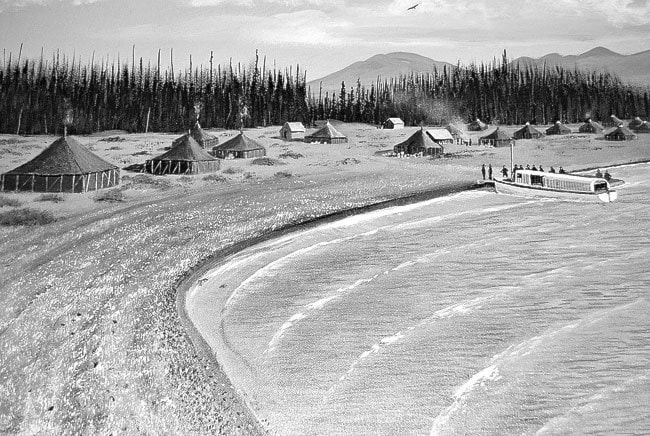As a testament to its importance in the development of the territory, the gold panner, ‘Yukon Sam,’ has been on the Yukon licence plate since 1953.
Until 1991, Sam even had a dab of hand-applied gold paint in his pan representing a gold nugget, his payload.
Since 1898 more than 13 million troy ounces have been mined from Yukon placer deposits worth $5.3-billion on today’s market, according to the Klondike Placer Miners Association.
Though panning is still an important part of mining in the Yukon, mining has taken many forms over the last century.
Miners use rocker boxes when there is limited water available to separate the gold from the gravel.
Sand and gravel are put in to the top of the box, and then miners literally rock the box back and forth like a cradle while a steady stream of water is poured over the mixture.
Larger rocks are caught in a large screen and fished out. The gold is caught in riffles at the bottom of the box and the excess water and rocks are washed out the side of the box.
Sluice boxes or sluice runs take a lot of water to work. In fact, one is best set up where a stream can run through it.
A sluice is a grooved channel or trough that sits on an incline. A stream of water and gold-bearing gravel flow through the sluice. Stones and sand pass through while gold and heavier minerals get caught in the grooves or riffles.
Sourdoughs say that the only way to find out what a claim is really worth is to get down to the bedrock. This was easier said than done, especially in the Klondike permafrost.
Miners had to haul firewood to their claims and then painstakingly thaw the frozen ground with a series of fires. The average rate of descent was .3 or .6 metres per day, and bedrock lay from 1.5 to 7.6 metres down.
Buckets of muck were hoisted to the surface, stockpiled and sluiced or panned for pay dirt. In 1898 Clarence Berry invented steam thawing, which could defrost eight to10 feet of frozen gravel each day.
Hydraulic mining uses a powerful stream of water from a monitor, also known as a giant, directed at gold-bearing gravel or sand. The combined forces of high-pressure water and air bubbles, which form in the water spout, cause the rock to dislodge.
Larger boulders were removed by human labour when possible. Water and loose sediment is diverted into sluice boxes in order to separate the gold from the sediment.
The face of mining changed in the Klondike in the early 1900s. By that time much of the easily accessible surface deposits had been mined out, so gold seekers had to find a way to process large amounts of less lucrative ground more economically.
Large mechanical dredges, described most eloquently in The Northern Gold Fleet as “animated houseboats,” were designed to process vast quantities of gravel in a short period of time.
The first large dredge appeared in the Klondike in 1905, and by 1911 they were the backbone of the Yukon gold mining industry.
A dredge works through a series of buckets, which scoop up gravel and deposit it into a washing trommel (a long cylinder which separates the coarse gravel from the fine gravel). The gold is then separated from the fine gravel by the sluice boxes beneath. Waste rocks are deposited behind the dredge in piles of coarse and fine tailings.
This column is provided by the MacBride Museum of Yukon History. Each week it will explore a different morsel of Yukon’s modern history. For more information, or to comment on anything in this column e-mail lchalykoff@macbridemuseum.com.
